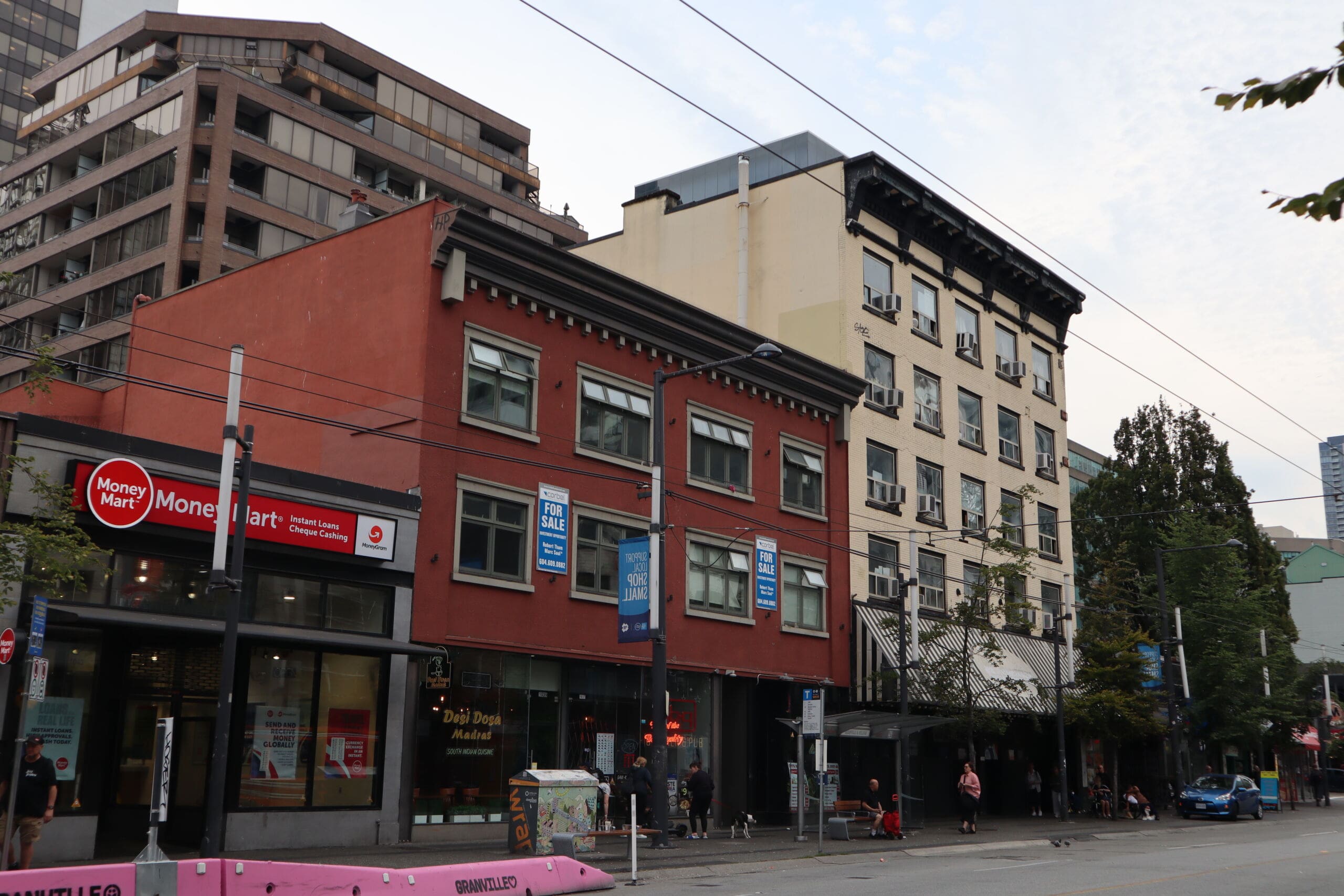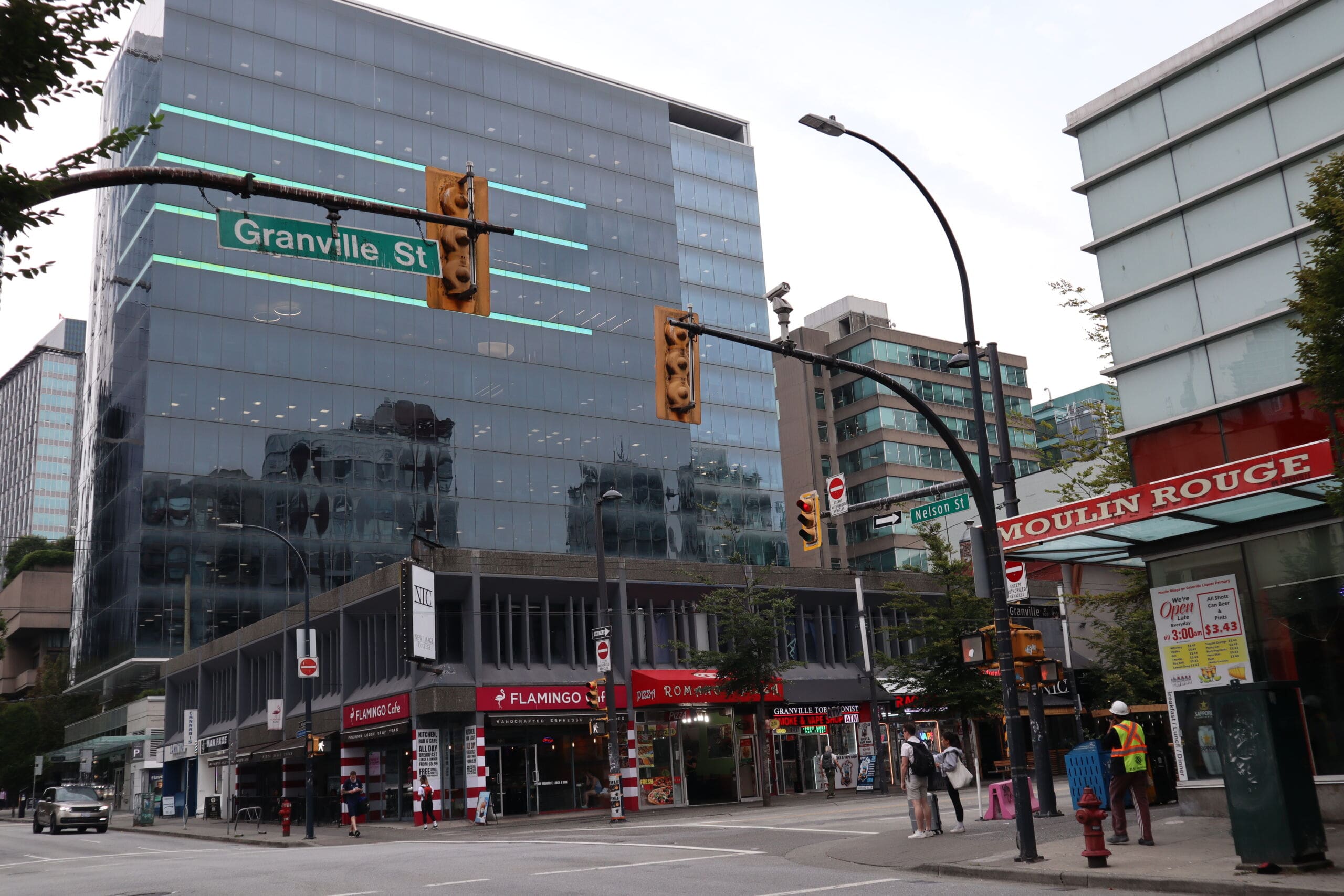A supportive housing failure in Vancouver is spurring innovative changes to Granville Street. Other cities are getting creative, too
Why It Matters
Canada’s housing crisis is disproportionately affecting low-income Canadians. Without creative intervention, homelessness will only get worse. The good news is that intervention is beginning to happen—here’s how.

They were created with the best of intentions during difficult times, but after thousands of calls to the Vancouver Fire Rescue Service and several dozen actual fires, single-room occupancy residences will be phased out along Vancouver’s Granville Strip.
“Many of those buildings, especially the hotels repurposed during COVID, are old, crumbling, and weren’t built to support long-term housing,” said Amanda Burrows, CEO of First United Church in Vancouver.
“This is what happens when you rely on band-aid solutions instead of building with intention.”
The city said it intends to address critical housing needs by gradually replacing existing single-room occupancy (SRO) units, ensuring displaced tenants are provided with alternative housing.
The move towards supportive housing is part of a 20-year plan to revitalize Vancouver’s downtown entertainment district, but is also indicative of larger concerns around safety and affordability playing out in urban municipalities across the country.
Non-profit housing providers hope it also signals a positive shift towards innovative solutions, new partnerships and better urban design.
Feds leave vacuum
Granville Street’s social housing challenges, like those in many Canadian cities, are rooted in decades of underinvestment and unintentional design, said Burrows.

According to the Parliamentary Budget Officer, most of Canada’s social housing stock was built before 1994. That decade marked a turning point, as the federal government largely withdrew from the sector.
Some provinces were able to step in and keep pace with demand, while others weren’t, said Ray Sullivan, executive director of the Canadian Housing and Renewal Association, a national non-profit advocating for systemic change.
“I think British Columbia is probably the only jurisdiction in the country right now that is managing to actually make progress in increasing the share of community housing as a percentage of all housing,” he said.
BC Housing, the crown corporation responsible for overseeing non-market housing in the province, supports affordable housing units designed for low and moderate-income earners.
These rental units have increased by nearly three per cent over the last year and make up 4.3 per cent of all housing units in the region.
Independent social housing units, unconnected to BC Housing, make up an additional three per cent, while co-operative housing units comprise 1.2 per cent of all regional rental units.
The province also introduced the Housing Supply Act in 2023, allowing it to set community housing targets based on need and projected population growth.
It’s resulted in a net increase of 16,000 new homes, according to numbers released by the B.C. government this spring.
Sullivan has worked in the social housing sector for 25 years, but says there’s been a renaissance in community housing in the past six years.
“We’ve expanded our capacity to build and to develop, and explored really interesting, new creative pathways of doing that,” he said.
“Unfortunately, it’s about a decade too late because the crisis has reached terrible proportions.”
Solutions that work
However, momentum around community land trusts and new social financing tools has Sullivan feeling optimistic about the future of social housing across Canada.
Not only are existing land trusts adding to their portfolios, but the number of new land trusts being established has increased exponentially over the last three or four years, he said, describing them as a “fantastic innovation.”
There are no land trusts on Granville Street, but the neighbouring Downtown East Side has an established community land trust that keeps property out of the private market and invests in affordable housing.
Housing providers in Vancouver and elsewhere are also leveraging new financial tools to maximize resources, he said.
“I’m seeing community housing providers and developers exploring new sources of capital financing, things like community bonds, things like social impact investments that are stacking on top of the usual government kind of sources of loans and grants, and allowing them to do that much more,” Sullivan said.
Collaboration among sectors is also growing, he added.
“We’re even seeing the early start of hybrid corporations, hybrid non-profit private corporations like Everbloom in Halifax, for example.”
Burrows hopes the city of Vancouver will consider innovative approaches like these when planning new supportive housing spaces outside of Granville.
Reimaging religious spaces
Housing solutions are also emerging from reimaged religious spaces. First United Church has transformed its Downtown Eastside location, which will soon offer social housing with wraparound supports.
Burrows said the model is both a practical and moral solution.
“There are some really tangible ways faith-based organizations can contribute,” she said.
“We’re using the land we have to build housing, plain and simple. There are so many churches sitting on underused or surplus land that could be doing the same.”
Burrows points to a broader trend among Christian congregations where declining attendance is paired with a desire to remain relevant.
“There’s huge potential, not just for housing but for things like daycares, preschools, recovery programs, community spaces, libraries. All the infrastructure that builds a thriving neighbourhood.”
First United’s project includes a new 11‑storey mixed‑use building with four floors of community services, such as a computer lab, washroom and shower facilities, and drop-in spaces.
The other seven floors will have below‑market and supportive housing operated by Lu’ma Native Housing Society, with 103 units primarily reserved for Indigenous residents, who make up 30 to 40 per cent of the Downtown Eastside’s population despite comprising only about two per cent of Metro Vancouver’s overall population.
“It’s not enough to redevelop for the sake of staying afloat,” she said. “We have to do it with meaning.”
“For us, that means addressing historic harms and making space for healing. Churches were part of the colonization project. Now we need to be part of the solution.”
In the middle of the country, a similar redevelopment is unfolding at All Saints Church in Winnipeg’s West Broadway neighbourhood.

The city is seeing a record number of unhoused citizens on its streets—more than 2,400 according to a recent survey—many of whom once camped out on the church’s property, challenging the congregation’s capacity to respond.
The solution was to build West Broadway Commons, a 12-storey, 110-unit residential building, next door. Half the suites are classified as affordable.
A 2023 survey by the City of Vancouver identified a similar number of people living rough in that community, meaning they had no shelter available to them. It also identified income as the primary factor driving individual homelessness, with 28 per cent of respondents identifying it as the leading cause of being unhoused.
However, creating affordable housing is only one part of the solution.
“Our project is purpose-built with wraparound supports, up-to-code infrastructure, and a focus on community,” said Burrows.
“You can’t just do ‘housing first’, it has to be housing with support, otherwise we’re setting people up to fail.”
To that end, All Saints Church in Winnipeg has taken a similar tack, partnering with community service organizations focused on helping youth, refugees, and vulnerable populations.
Tiny homes, big impact
The housing crisis has also hit Canada’s East Coast, but recent data suggests positive developments are on the horizon in New Brunswick: the number of people considered unhoused in Fredericton has fallen since January.
Innovative solutions, like the 12 Neighbours project, are helping people get off Fredericton streets and out of the city’s parks. Over the last two years, it’s delivered 96 tiny homes to a planned community, building one new house every couple of weeks.
The homes are fully equipped with appliances and furniture, and rent is capped at 30 per cent of income.
It’s a unique model, and Marc Lee, a senior economist with the Canadian Centre for Policy Alternatives, believes it needs greater government support.
“Increasingly, governments have been trying to get more development, either public-led, non-market or cooperative housing. But they haven’t been particularly well-funded so far,” he said.
“There’s been a lot more talk than there’s been action.”
Using co-operative or other non-profit models to build Canada’s housing stock is part of a broader solution, Lee said.
“But then you’re also going to need specific services and housing aimed at populations who can’t really take care of themselves.”
Residents of 12 Neighbours benefit from peer support, employment opportunities, and wrap‑around inclusion services.
New Brunswick’s Premier Susan Holt has also pledged to build 30,000 new houses by 2030 in an effort to make housing more affordable.
Modern approaches in Ontario
With more than 81,000 residents experiencing homelessness, Ontario is at the forefront of the housing emergency.
According to Statistics Canada, 136,600 Ontario households were on waitlists for affordable or social housing in 2022, the most recent year for which data is available. Three times as many as in neighbouring Quebec.
A pilot project in Southern Ontario is working to change that, while also reimagining what supportive housing looks like.
Indwell Community Homes is creating affordable, energy-efficient homes in Hamilton and London that provide residents with built-in support, including integrated mental health and addiction support, community-building programs, and tenant-led social networks.
However, Graham Cubitt, Indwell’s director of projects and development, said supportive housing isn’t always welcomed by everyone.
“There are many layered costs of unresolved homelessness that neighbourhoods bear, yet sometimes new neighbours unfamiliar with Indwell fear supportive housing will exacerbate those issues,” said Cubitt.
“Supportive housing ends homelessness, as tenants immediately have homes. They can lock their own front door as they set new boundaries and start rebuilding their health and life around new goals.”
The project, funded through Housing Supply Challenge grants, aims to show how on-site healthcare services and an inclusive community can help stabilize vulnerable people.
Ottawa and Ontario have jointly promised to spend $357 million on affordable housing in that province over the next three years. Ontario’s Third Action Plan promises to expand rent-assisted social housing while preserving existing community housing stock.
According to information provided by the Government of Ontario, these initiatives aim to protect current rent-geared-to-income tenants, increase the supply of affordable units, and deliver portable housing benefits to vulnerable households across the province.
Next steps for Granville
Back in Vancouver, social housing proponents are waiting to hear more details about what will replace Granville Street’s old hotels turned SROs as the area is reimagined as a lively, car-free zone.

The city promises to relocate 283 units to five smaller, city-operated facilities, each offering about 60 units, but locations are still being finalized.
Current residential buildings in the area may continue to operate, but the revitalization plan limits redevelopment to non-residential uses, leaving some with questions about where replacement housing will be developed.
Earlier this year, Vancouver Ken Sim said the facilities would have wrap‑around mental health services, while others have stressed the need to improve safety in the area.
“Granville has always been a place where people gather—for music, nightlife and community gatherings. This plan helps us honour that legacy while addressing the real challenges the street faces today,” said Josh White, General Manager of Planning, Urban Design and Sustainability.
“We’re creating a path to revitalize the district in a way that’s inclusive, vibrant and future-focused.”

